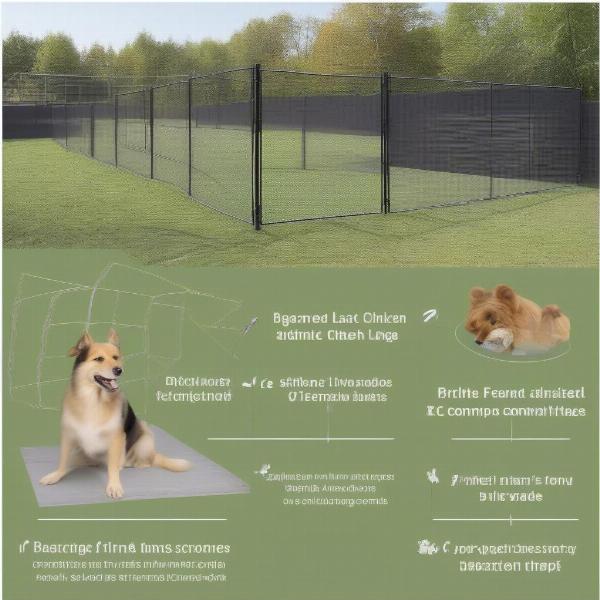Keeping your furry friend safely contained in your yard doesn’t have to break the bank. There are a number of affordable and effective solutions available, from DIY fencing options to training techniques that reinforce boundary awareness. This article will explore the cheapest way to keep a dog in your yard, covering everything from simple solutions to more robust, yet still budget-friendly, options. We’ll also discuss the importance of considering your dog’s breed, temperament, and energy levels when choosing the best containment method.
Exploring Budget-Friendly Fencing Options
When it comes to containing your dog, fencing is often the first solution that comes to mind. While professional installations can be expensive, several cheaper alternatives exist. One of the most affordable options is using readily available materials like chicken wire or chain link. These can be easily installed with posts and basic hardware, creating a secure barrier without the hefty price tag. Another budget-friendly option is using pre-fabricated panels, which are readily available at most hardware stores. These can be quickly assembled and installed, significantly reducing labor costs.
 Cheapest Dog Fencing Options
Cheapest Dog Fencing Options
For dogs that are prone to digging, consider burying chicken wire or hardware cloth along the fence line. This creates an underground barrier that deters escape attempts. Alternatively, you can create a gravel border around the perimeter of the fence. Dogs typically dislike the feeling of gravel on their paws, making it less likely they’ll dig near the fence.
Leveraging Natural Barriers and Landscaping
Incorporating natural barriers and strategic landscaping can be a cost-effective way to reinforce your existing fence or even create a boundary without traditional fencing. Dense shrubs and bushes can act as a visual and physical deterrent, discouraging your dog from venturing beyond the designated area. Planting thorny bushes along the fence line can add an extra layer of protection.
Remember to choose pet-safe plants as some varieties can be toxic to dogs. Researching dog-friendly landscaping options will ensure a beautiful and safe environment for your furry companion.
Training for Boundary Awareness
Training plays a crucial role in keeping your dog safely within your yard. Teaching your dog strong recall and boundary commands like “stay” and “come” can significantly reduce the likelihood of escapes. Consistent positive reinforcement training, using treats and praise, can establish clear boundaries and reinforce desired behaviors.
Invisible Fences: A Cost-Effective Alternative?
While the initial cost of an invisible fence can be higher than some DIY fencing solutions, it can be a cost-effective alternative in the long run, eliminating the need for traditional fencing materials. These systems use a buried wire to create a boundary that delivers a mild static correction when your dog approaches the edge. While not suitable for all dogs, invisible fences can be an effective solution for many, especially in areas with fencing restrictions.
Conclusion
Keeping your dog safely contained in your yard doesn’t require a fortune. By exploring budget-friendly fencing options, leveraging natural barriers and landscaping, and prioritizing training, you can create a secure and stimulating environment for your furry friend without emptying your wallet. Remember to choose the best method based on your dog’s individual needs and your specific yard environment.
FAQ
- What is the absolute cheapest way to fence a dog? Using readily available materials like chicken wire combined with repurposed posts or pallets can be the most budget-friendly DIY option.
- Is an invisible fence cheaper than a regular fence? The initial investment for an invisible fence might be higher, but it can be cheaper in the long run as it eliminates the need for traditional fencing materials and labor.
- How can I train my dog to stay in the yard without a fence? Consistent positive reinforcement training, focusing on recall and boundary commands, is key to establishing off-leash reliability.
- What are some natural ways to keep a dog in the yard? Planting dense shrubs and thorny bushes along the property line can act as a natural deterrent.
- What type of fencing is best for a dog that digs? Burying chicken wire or hardware cloth along the fence line, or creating a gravel border, can prevent digging escapes.
- Can I use landscaping to keep my dog in the yard? Yes, strategic landscaping with dense bushes and shrubs can create a natural barrier.
- What’s the best way to reinforce my existing fence to keep my dog in? Adding a fence topper or burying chicken wire at the base are effective ways to reinforce your current fence.
Related Articles:
- keep a dog from jumping fence
- cheapest fencing for dogs
- cheap way to cover dirt in backyard with dogs
- fence topper for dogs
About ILM Dog:
ILM Dog is your go-to resource for expert advice on dog breeds, health, training, nutrition, grooming, and much more. We offer practical tips and insights to help you provide the best possible care for your canine companion. Whether you’re a seasoned dog owner or just starting your journey, ILM Dog has the information you need. Contact us today for personalized advice: Email: [email protected], Phone: +44 20-3965-8624.